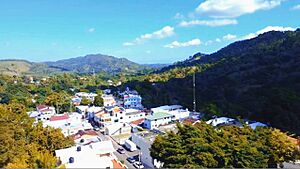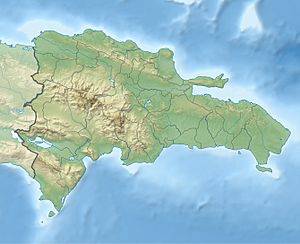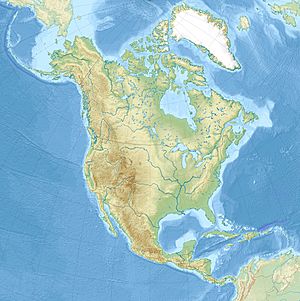Altamira, Dominican Republic facts for kids
Quick facts for kids
Altamira
|
||
|---|---|---|

View of Altamira
|
||
|
||
| Country | Dominican Republic | |
| Province | Puerto Plata | |
| Area | ||
| • Total | 179.32 km2 (69.24 sq mi) | |
| Population
(2012)
|
||
| • Total | 26,056 | |
| • Density | 145.304/km2 (376.337/sq mi) | |
| • Urban | 7,889 | |
| Municipal Districts | 1 |
|
Altamira is a town located in the Puerto Plata Province of the Dominican Republic. It is a place with interesting history and beautiful nature.
The town's name, Altamira, has two main stories about where it came from. One story says that when Christopher Columbus first saw the area, he was amazed by the tall mountains. He supposedly said, "Look at the heights!" The word "Altamira" means "high view" or "look at the heights." Another story suggests the name comes from how the region looks similar to the famous Altamira Caves in Spain.
On October 29, 1889, the president at the time, Ulises Heureaux, officially made Altamira a municipality. A municipality is like a local government area. To this day, people in Altamira celebrate October 29 with special town parties and events.
Contents
History of Altamira
In its very early days, Altamira was mostly made up of large farms. Families from smaller farms nearby moved there to work. Because of this, some people still call Altamira's famous tobacco farms the "Ranches of Puerto Plata."
During a difficult time called the Devastations of Ozoria, the community of Altamira was very important. It helped keep communication open between the Cibao Valley and Port Silver. It also offered a safe place for people who did not want to leave the region.
During a period called the Annexation, Altamira became part of the Santiago Province in 1845. After the War of Restoration, which brought independence back, Altamira became even more important. It was not just a key military spot, but also a growing place for people and businesses.
After the War of Restoration, Altamira grew from scattered shacks into a small village. About 60 to 75 families lived there. They grew crops that grew quickly and raised animals. Business slowed down during the war, but it quickly picked up afterward. At that time, Altamira had only one main street, called "Street of the Commerce." On this street, you could find shops selling clothes, shoes, groceries, and household items.
When Altamira became a municipality, its first leader was General Don José Hilario Francisco. His helper, Manuel "Manuelita" Peña, was the chief of police. The town's first Catholic priest was Juan Albino. All three were sworn into their roles by Pedro Pepín, the Governor of Puerto Plata.
The street now known as San José was first built in 1890. It was called the "Street of the Donkeys." This was because donkeys were the main animals used for carrying things back then, and you would see them everywhere on that street.
A railroad line connecting Puerto Plata and Santiago opened in 1897. Its main station was in Altamira's La Piedra area. People say that traveling between the two cities by train took about two and a half hours.
Geography of Altamira
Altamira is located in the Cordillera Septentrional, which is a mountain range. It sits about 400 meters (about 1,300 feet) above sea level. The area has a humid forest climate, meaning it gets a good amount of rain and has lush greenery.
The town is located between 19.6 and 19.7 degrees North latitude and 70.7 and 70.8 degrees West longitude. It has neighbors all around it:
- To the north is the municipality of Imbert.
- To the south is Santiago Province.
- To the west are the municipalities of Guananico and Hope.
- To the east is the municipality of San Felipe.
Altamira covers an area of about 188.08 square kilometers (about 72.6 square miles). This makes it the fifth largest municipality in the Dominican Republic by area. It is divided into eight main regions: Río Grande, Pescado Bobo, El Mamey, Palmar Grande, Los Llanos, Higüero, Quebrada Honda, and Escalera.
Climate
| Climate data for Altamira, Puerto Plata (1961–1990) | |||||||||||||
|---|---|---|---|---|---|---|---|---|---|---|---|---|---|
| Month | Jan | Feb | Mar | Apr | May | Jun | Jul | Aug | Sep | Oct | Nov | Dec | Year |
| Record high °C (°F) | 32.5 (90.5) |
33.5 (92.3) |
37.2 (99.0) |
36.5 (97.7) |
36.0 (96.8) |
36.0 (96.8) |
36.0 (96.8) |
36.0 (96.8) |
36.3 (97.3) |
36.0 (96.8) |
37.5 (99.5) |
32.7 (90.9) |
37.5 (99.5) |
| Mean daily maximum °C (°F) | 27.2 (81.0) |
27.9 (82.2) |
29.0 (84.2) |
29.6 (85.3) |
30.8 (87.4) |
32.2 (90.0) |
32.1 (89.8) |
32.3 (90.1) |
32.2 (90.0) |
31.5 (88.7) |
29.3 (84.7) |
27.5 (81.5) |
30.1 (86.2) |
| Mean daily minimum °C (°F) | 17.1 (62.8) |
17.3 (63.1) |
17.8 (64.0) |
18.6 (65.5) |
19.9 (67.8) |
20.7 (69.3) |
20.6 (69.1) |
20.8 (69.4) |
20.7 (69.3) |
20.3 (68.5) |
18.8 (65.8) |
17.6 (63.7) |
19.2 (66.6) |
| Record low °C (°F) | 12.5 (54.5) |
11.5 (52.7) |
12.0 (53.6) |
11.0 (51.8) |
13.4 (56.1) |
15.2 (59.4) |
17.2 (63.0) |
17.0 (62.6) |
17.4 (63.3) |
16.0 (60.8) |
14.0 (57.2) |
13.0 (55.4) |
11.0 (51.8) |
| Average rainfall mm (inches) | 136.0 (5.35) |
106.2 (4.18) |
108.8 (4.28) |
166.1 (6.54) |
207.1 (8.15) |
117.7 (4.63) |
67.6 (2.66) |
82.4 (3.24) |
140.6 (5.54) |
199.3 (7.85) |
270.6 (10.65) |
198.1 (7.80) |
1,800.5 (70.89) |
| Average rainy days (≥ 0.1 mm) | 7.6 | 6.0 | 6.3 | 8.1 | 10.2 | 7.1 | 6.8 | 6.3 | 8.3 | 10.9 | 11.3 | 9.4 | 98.3 |
| Source: NOAA | |||||||||||||
Culture and Fun in Altamira
Altamira has a very rich culture with many traditions and activities.
Cultural Groups and Events
- Grupo Cultural Ugaca (a local cultural group)
- Palos y Atabales (traditional drum music and dance)
- Velas Ofrecidas (a traditional offering ceremony)
- Canto Folklórico La Pepa (folk singing)
- Canto y Baile Folklórico El Machacó (folk singing and dancing)
- Fiestas Patronales (town patron saint festivals)
- Anniversario de Altamira (celebration of Altamira's anniversary)
- Viacrusis de la Iglesia (a religious procession)
- Club Hijos Y Amigos de Altamira N.Y. (a club for people from Altamira living in New York)
Important Natural Areas
- Los Picos de Río Grande; Pilar y Angostura (peaks in the Río Grande area)
- El Pico Diego De Ocampo (a famous peak)
- Loma de los Puntieles (Los Lirios y Guazaral) (hills)
- Alto de Bohío (a high point)
- Loma de la Prieta (a hill)
- La Lomota (another hill)
- Los Manantiales (springs)
- Loma el Gallo (a hill)
- Loma de Quinigua (a hill)
Recommended Places to Visit
Altamira is home to many beautiful natural swimming spots, often called "balnearios."
- Balneario Natural Las Angostura (Río Grande Abajo)
- Balneario Montaña Verde (Quebrada Honda)
- Saltadero la Damajagua (Palmar Grande)
- Balneario Boca de Río Grande (Palmar Grande)
- Charco la Piedra (Palmar Grande)
- Balneario Cuevas de las Aguas (Escalera)
- Balneario El Almacén (Río Grande)
- Balneario Charco de la Paila (El Almacén)
- Balneario Bellaco (Bajabonico Arriba)
- Balneario Agua Fresca (Quebrada Honda)
- Balneario La Bajaita (El Puente la Jagua)
- Balneario el charco de pilar (Rio grande abajo)
Notable People from Altamira
Altamira has been home to some famous people:
- Bartolo Colón (born in 1973) is a professional baseball player from the Dominican Republic. He won the 2005 AL Cy Young award, which is given to the best pitcher in baseball. He holds the record for the most career wins by a pitcher born in Latin America, with 247 wins.
- Donaciano Chanito Vargas was the mayor of Altamira from 1966 to 1968.
- Wilfrido Vargas (born in 1949) is a famous band leader, trumpeter, singer, and music producer.
Images for kids
See also
 In Spanish: Altamira (República Dominicana) para niños
In Spanish: Altamira (República Dominicana) para niños






